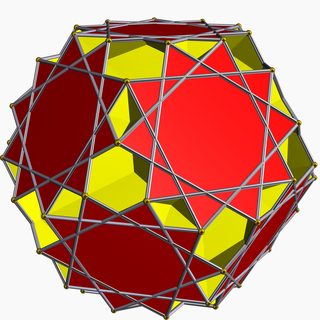
Summary
| Great dodecicosahedron | |
|---|---|

| |
| Type | Uniform star polyhedron |
| Elements | F = 32, E = 120 V = 60 (χ = −28) |
| Faces by sides | 20{6}+12{10/3} |
| Coxeter diagram | |
| Wythoff symbol | 3 5/3 (3/2 5/2) | |
| Symmetry group | Ih, [5,3], *532 |
| Index references | U63, C79, W101 |
| Dual polyhedron | Great dodecicosacron |
| Vertex figure |  6.10/3.6/5.10/7 |
| Bowers acronym | Giddy |
In geometry, the great dodecicosahedron (or great dodekicosahedron) is a nonconvex uniform polyhedron, indexed as U63. It has 32 faces (20 hexagons and 12 decagrams), 120 edges, and 60 vertices.[1] Its vertex figure is a crossed quadrilateral.

It has a composite Wythoff symbol, 3 5⁄3 (3⁄2 5⁄2) |, requiring two different Schwarz triangles to generate it: (3 5⁄3 3⁄2) and (3 5⁄3 5⁄2). (3 5⁄3 3⁄2 | represents the great dodecicosahedron with an extra 12 {10⁄2} pentagons, and 3 5⁄3 5⁄2 | represents it with an extra 20 {6⁄2} triangles.)[2]
Its vertex figure 6.10⁄3.6⁄5.10⁄7 is also ambiguous, having two clockwise and two counterclockwise faces around each vertex.
Related polyhedra edit
It shares its vertex arrangement with the truncated dodecahedron. It additionally shares its edge arrangement with the great icosicosidodecahedron (having the hexagonal faces in common) and the great ditrigonal dodecicosidodecahedron (having the decagrammic faces in common).
| Truncated dodecahedron |
Great icosicosidodecahedron |
Great ditrigonal dodecicosidodecahedron |
Great dodecicosahedron |
Gallery edit
| Traditional filling |
Modulo-2 filling |
See also edit
References edit
- ^ Maeder, Roman. "63: great dodecicosahedron". MathConsult.
- ^ Wenninger, Magnus (1974). Polyhedron Models. Cambridge University Press. ISBN 0-521-09859-9. pp. 9–10.
External links edit
- Weisstein, Eric W. "Great dodecicosahedron". MathWorld.


